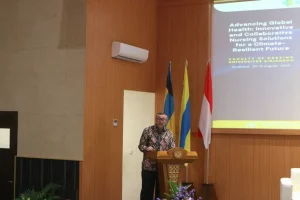Mortality in children with pneumonia reaches 2,500 cases per day or approximately 2 toddlers die every minute. WHO has reported that 16 percent of toddlers’ death case was due to pneumonia in 2015. In the same year, UNICEF reported that approximately 14 percent of 147,000 toddlers in Indonesia die of pneumonia (Budiharjo & Suryawan, 2020). According to the previous research, it is concluded that pneumonia is a dangerous disease that leads to death, especially for toddlers. The study aims to analyze the risk factors for exclusive breastfeeding, smoking behavior, and housing density in pneumonia cases in toddlers in Indonesia. This study was conducted using meta-analysis, a statistical method that quantitatively combines several articles. The data were sorted using inclusion and exclusion criteria. The PICOS method was used to find the articles as the reference. All full-text articles consisted of 44 articles, with 21 articles for the variable of exclusive breastfeeding, 14 articles for the variable of smoking behavior in family members, and 16 articles for the variable of housing density. The data was processed using JASP version 0.14.1, followed by data analysis.
From 2010-2014, pneumonia cases in Indonesia ranged from 20-30 percent and the number kept increasing from 2015-2019. The rising pneumonia cases in toddlers were caused by various factors, including parents’ behavior, smoking behavior in family members, and surroundings. Advanced studies need to be done to analyze some factors causing pneumonia on toddlers.
The result of the study showed that based on the forest plot exclusive breastfeeding reached 1,934 (95 percent Cl 0.46-0.86). Toddlers who are not exclusively breastfed have a risk of 1,934 times for pneumonia compared to toddlers who are exclusively breastfed. The results of the forest plot of the smoking behavior of family members obtained a value of 2,585 (95% CI 0.69-1.21). It can be seen that the smoking behavior of family members is 2,585 times more likely to develop pneumonia compared to the non-smoking behavior of family members. The results of the forest plot that the density of residential homes has a risk of pneumonia in children under five with a value of 1,934 (95% CI 0.42-0.91). It can be seen that children under five who live in densely populated homes have a 1,934 times greater risk of developing pneumonia in their bodies compared to toddlers who live in houses that are not densely populated.
Ministry of Health of the Republic of Indonesia in 2001 stated that in general, there are three factors that can influence the incidence of pneumonia in toddlers, the behavior of the parents (mother), the individual aspects of the child, and the environment around the child. The increased risk of various diseases such as pneumonia can be triggered by the physical environment in the house that cannot meet health and fuel use behavior which results in pneumonia. Densely populated houses and parents’ smoking habits are environmental factors that can increase the occurrence of pneumonia in toddlers (Anwar & Dharmayanti, 2014).
The highest risk factor for pneumonia in toddlers in Indonesia is the smoking behavior of family members. These variables have a risk of 2,585 times greater for the occurrence of pneumonia compared to the behavior of family members who do not smoke. Several efforts can be made to minimize risk factors by conducting periodic counseling and promotions regarding the dangers of smoking to toddlers by dealing with them. Families with toddlers are expected to stop smoking, especially at home or near toddlers.
Author: R. Azizah
Journal link: http://cmhp.lenterakaji.org/index.php/cmhp/article/view/65









